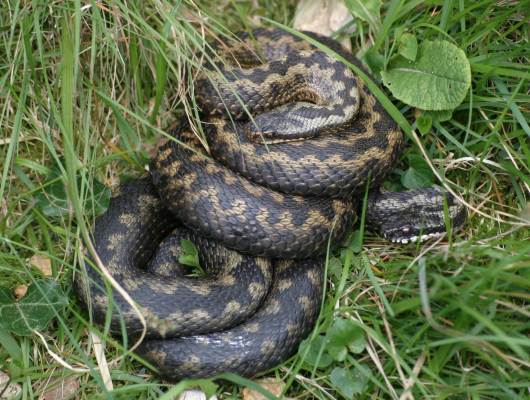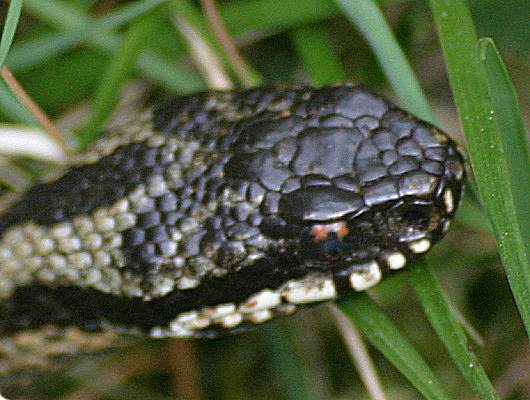Trees Birds Mammals Fish Amphibians Reptiles
Wild Algarve
Bookshop
Vipera berus - European Adder or Common Viper
Phylum: Chordata - Class: Reptilia - Order: Squamata - Family: Viperidae
Identification - Distribution - Lifecycle - Food - Predators - Reference Sources

Adders are Britain's only venomous snake, but unless alarmed, cornered or handled they pose little threat to people.
Identification
A full-grown adult Adder is typically 50 to 65 cm long, and
occasionally females can grow to over a metre long; however, for the most
part Adders are shorter and invariably much thicker than grass snakes. The grey-brown background colour of the Adder is quite
different from the dark green of a Grass Snake, and yet many people have
difficulty distinguishing the two. Adders have a dark zigzag
running along the back and a dark Vee on the back of the head. The point of the Vee is between the eyes. The patterning and the
background colour become duller just before the snake sheds (sloughs) a
skin.

Above: an entirely black Adder
Occasionally in the UK you may come across an entirely black form of this snake. Black Adders are most frequently reported from the New Forest (Hampshire) and the Gower Peminsula (South Wales).
Distribution
European Adders - also known as - are found throughout Britain (but not Ireland) and
are particularly common on heathland and on grassy cliff-tops and slopes,
where they like to bask in open areas (including on footpaths). Unlike
Grass Snakes, Adders do not like wet places. They are Britain's only venomous
snakes, and although very poisonous an Adder's bite rarely proves fatal
for an adult. Even so, if you go walking in Adder habitat it is advisable
to wear stout footwear that will protect your ankles. On the European mainland their range extends from Scandinavia down to northern Italy and Greece, but they are absent from the Iberian Peninsula. This venomous snake has an eastern range extending through Russia and into Mongolia and northern China.

Lifecycle
Adders are viviparous. The eggs develop and hatch in the body of the
female Adder. Typically ten baby Adders, 16 to 18cm long, are born in mid
summer; they are able to reproduce when they are five years old. The life
span of a European Adder is up to 15 years. Like other reptiles,
they hibernate under the ground throughout the cold winter months, usually
choosing the same place each year.
Food
The diet of Adders is very varied and includes voles and other small
rodents, lizards, birds' eggs, insects and snails. They begin their hunting for food at dusk and are most active
during the first few hours of darkness, travelling up to 100 metres from
their lair (which is often the hole made by another animal).

The Wildlife and Countryside Act provides very strict
protection for this snake. If you come across an Adder you should not
handle or even disturb it.
Predators
Adders have several enemies including foxes, badgers and some of the
larger owls.
Reference Sources
Matching the Hatch by Pat O'Reilly (2017) - learn all about aquatic insects and other small water creatures that feature in the diet of reptiles.
Acknowledgements
This page includes pictures kindly contributed by Betty and Tony Rackham.